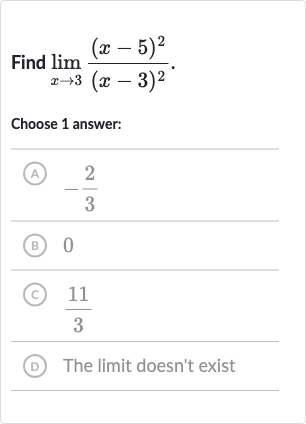Full solution
Q. Find .Choose answer:(A) (B) (C) D D The limit doesn't exist
- Identify the form: Identify the form of the limit.We are asked to find the limit of the function as approaches . Let's plug in to see what form the limit takes.We notice that the denominator becomes , which suggests that the limit might be of the form , indicating a possible indeterminate form.
- Simplify the expression: Simplify the expression if possible.Since we have an indeterminate form, we can try to simplify the expression or use L'Hôpital's Rule. However, in this case, the expression is already in its simplest form, and L'Hôpital's Rule is not necessary because we can directly evaluate the limit by canceling out the common factors.
- Factor and cancel: Factor and cancel if possible.We notice that the numerator and the denominator are both perfect squares. Let's factor them out:.Now, we can see that the term will not be zero when x approaches , so we can evaluate the limit by plugging in :.However, we made a mistake here. We cannot divide by zero, and the term in the denominator will indeed be zero when , which means we cannot simply plug in the value of .
More problems from Compare linear and exponential growth
QuestionGet tutor help
QuestionGet tutor help
QuestionGet tutor help
QuestionGet tutor help
QuestionGet tutor help
QuestionGet tutor help
QuestionGet tutor help

